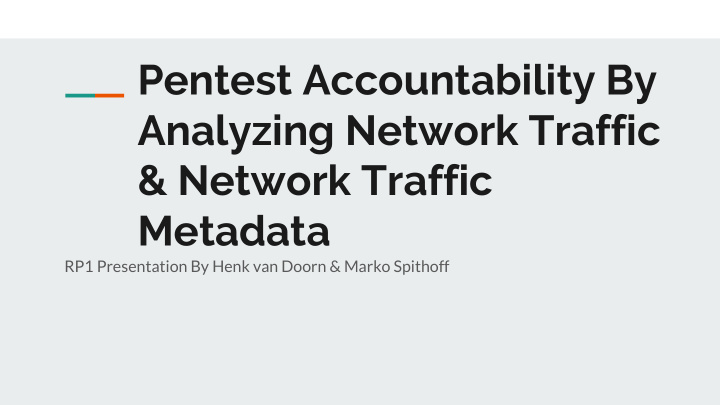



Pentest Accountability By Analyzing Network Traffic & Network Traffic Metadata RP1 Presentation By Henk van Doorn & Marko Spithoff
Relevance Security Audits ○ Company Detects (Attempted) Breach ○ Accountability Of Actions 2
Research Questions Is it feasible to log all network traffic live during the execution of a ● pentest given specific storage, CPU and throughput constraints? When performing a live capture of network metadata during the ● execution of a pentest, What information can be extracted from the metadata? ○ Can accountability of actions be provided based on metadata from the captured ○ network traffic? Based on the metadata from the captured network traffic could the captured traffic ○ be categorized into attack vectors of the Intrusion Kill Chain? 3
Research Questions Continued Is it feasible to log network metadata live during the execution of a ● pentest given specific storage, CPU and throughput constraints? What legal aspects come into consideration when storing the collected ● (meta)data based on current European legislation? 4
Research Questions ● Is it feasible to log network traffic live during the execution of a pentest given specific storage, CPU and throughput constraints? Metadata ❏ Full Capture ❏ 5
Related Work What Is Pentesting (Bishop) ● Cyber Kill Chain (Hutchins et al.) ● Using Metadata For Security Analysis (Feamster) ● Fast Portscan Detection (Jung et al.) ● Metadata Based Intrusion Detection (Yasinsac And Leckie) ● Toward Scalable Internet Traffic Measurement and Analysis with ● Hadoop(Lee and Lee) 6
Taxonomy Of A Pentest US DOD, Clark Hutchins et al. 7
Experiment Setup 8
Full Data Capture 9
Flowchart PCAP conversion Prevent file conflicts ● Convert to JSON ● Import into MongoDB ● Remove old files ● 10
Results:Full Data Capture Verification % sudo ping -f -c 1000000 192.168.1.107 1000000 packets transmitted, 1000000 received, 0% packet loss, time 151825ms MongoDB Enterprise > db.ICMP.count({ "layers.icmp" : {"$exists" : true}}); 2000000 11
Metadata Capture 12
Results: Metadata Capture Software Limitations ● Scapy vs Sockets ○ Python vs C ○ Hardware Constraints ● Storage ○ CPU ○ Network ○ Memory ○ Disk IO ○ 13
Nmap TCP Detection Mean Completion Time: 13.302947s ● Mean Time Between Packets: 0.281ms ● Target Receives 1714 TCP Syn Packets ● TCP Syn Sequence Stays The Same ○ 14
Results: Nmap TCP Detection 100 Nmaps Performed From Virtual Host ● 100 Nmap Scans Detected ● Port Scan Detected On: 2018-01-31 11:30:43,993446, From IP: 192.168.1.109, To ○ IP:192.168.1.108, TCP Sequence:2393481580 Port Scan Stopped On: 2018-01-31 11:30:47,907038, Number Of Ports Scanned ○ 615, TCP Sequence:2393481580 Accountability: Plausible ● 15
Tcp Shell Detection Character At A time Mode ● "almost all requests to web servers have their TCP PUSH and ACK ● flags set" (Roesch et al.) Could This Be Applied To TCP Shells? ○ 16
TCP Shell Detection Continued 17
Results:TCP Shell Detection 100 Reverse TCP Shell Connections Build & Destroyed ● 100 Reverse TCP Shells Detected ● Connection Detected On: 2018-01-29 14:50:58,419131, IP: 192.168.1.108:8080, ○ Connects To IP: 192.168.1.107:39294 Connection Stopped On: 2018-01-29 14:51:08.424046, From IP: ○ 192.168.1.108:8080, To IP: 192.168.1.107:39294 Accountability: Plausible ● 18
Results Storing All Network Traffic Seems Plausible With Enterprise Solutions ● 12 Hour Total 5,5 GiB ○ Storing All Network Metadata Seems Plausible With Small Business ● Solutions 12 Hour Total 261 MiB ○ Achieving Accountability Seems Plausible Using Metadata ● Hardware Performance Differences ● Further Research Needed For Proposed Methods ● Scapy Makes Inefficient Use Of System Resources ● Python Is Not Fast Enough To Log Traffic Realtime ● 19
Discussion Legal Aspects Of Storing All Data ● 20
Future Work Research Into Proposed Methods ● Other TCP Protocols ○ Detection Methods Known Or New? ○ Rewriting The Methods Into C ● Rewrite Methods For UDP Thresholds ● Effect Of VPN’s On Proposed Methods ● Multithreading on pcap(ng) ● 21
Questions? 22
Recommend
More recommend